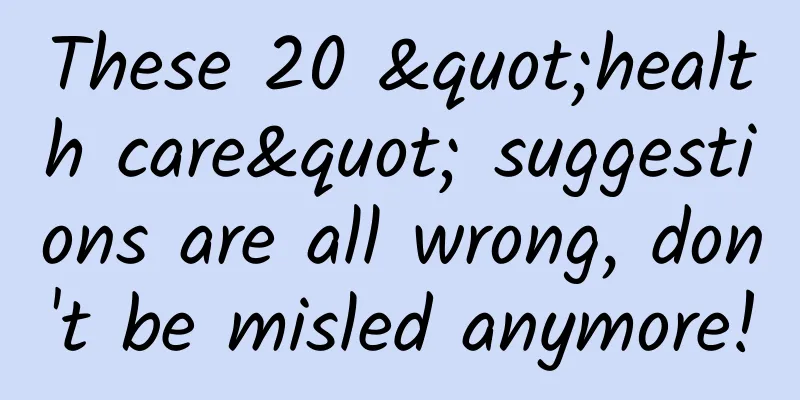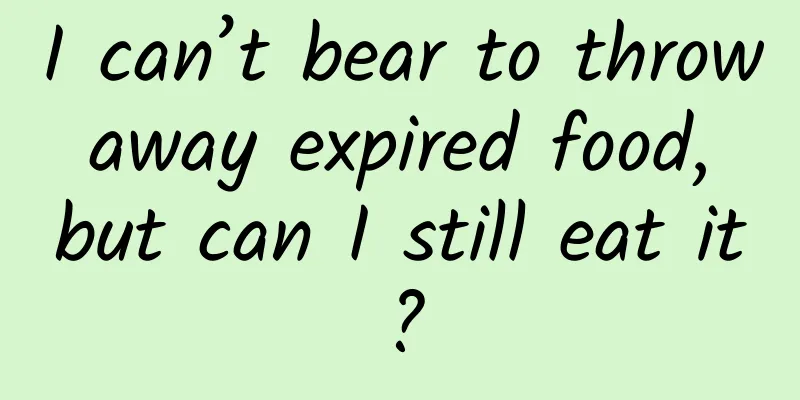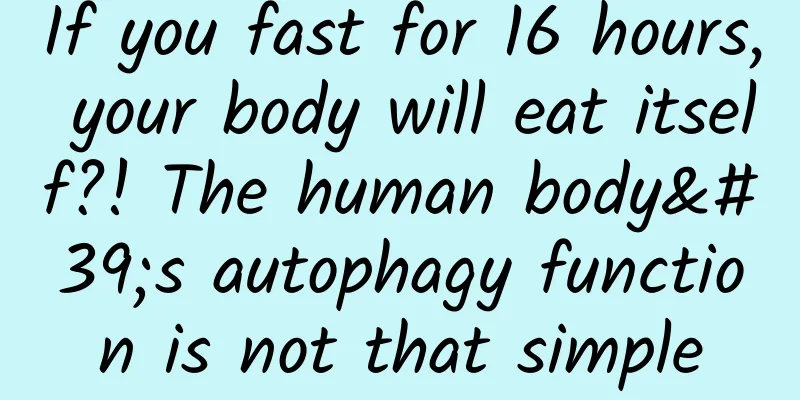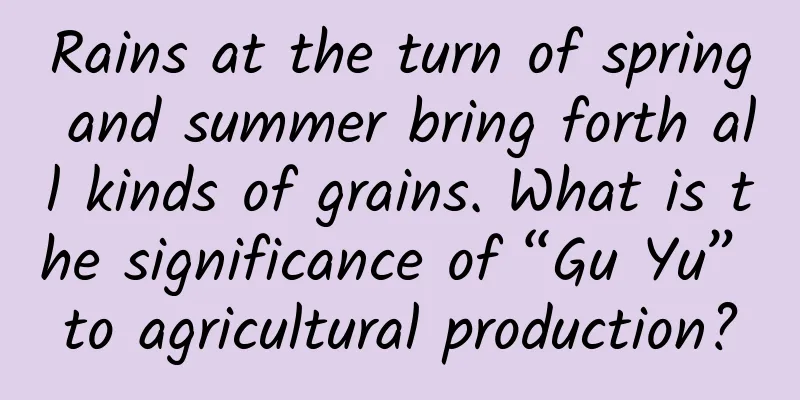These 20 "health care" suggestions are all wrong, don't be misled anymore!

|
“Drinking more porridge can nourish the stomach”, “Fruit can be eaten even if it has a small mold spot”... Many of the well-known “health suggestions” about three meals a day may actually be wrong and have misled many people. 01 Staple Food 1. Not eating staple foods can help you lose weight quickly, wrong! Li Ying, deputy chief physician of the Nutrition Department of Xuanwu Hospital, Capital Medical University, said that not eating staple foods to lose weight is not recommended. Staple foods are the most economical, affordable and least taxing source of energy for the liver and kidneys, and the only source of energy for the central nervous cells in the human brain is blood sugar. Therefore, it is wrong not to eat staple foods. It is just recommended to choose more coarse grains when choosing staple foods. 2. It is best to only eat coarse grains as staple food. Wrong! For the elderly, it is advisable that coarse grains account for one-third of the total staple food of the day, and no more than half. Chen Qizhong, director of the nutrition department at the Ningxia Medical University General Hospital, said in an interview with China Daily that people are usually more active during the day, so they can eat more whole grains at noon to help digestion . It is best to eat refined grains instead of coarse grains at night. 3. Drinking more porridge can nourish the stomach, wrong! "Do you feel sick in your stomach? Drink some porridge to nourish yourself!" Do you believe these words? Jia Kai, chief physician of the Department of Gastroenterology at Beijing Chaoyang Hospital, said that not all patients with stomach problems are suitable for drinking porridge. For example, patients with gastroesophageal reflux disease are not suitable for drinking porridge. This is because porridge is relatively thin, and patients are prone to reflux after drinking it, which can cause acid in the stomach and aggravate the condition. It is not recommended for this type of patients to eat too much liquid food. They are suitable for eating semi-liquid or semi-solid food. Copyright image, no permission to reprint 4. Steamed buns raise blood sugar levels quickly, so you should eat more rice. Wrong! Some diabetic patients found that their blood sugar levels were higher after eating steamed bread than after eating rice, so they believed that steamed bread raises blood sugar levels faster than rice. Liu Peng, chief physician of the clinical nutrition department of Peking University People's Hospital, said that the carbohydrates and glycemic index of flour and rice of the same weight are very similar, and there is no particularly big difference in the impact on blood sugar. Whether it is rice, noodles or steamed buns, diabetics must control the amount and consume it reasonably. 02 Fruits and vegetables 1. Not eating enough fruits and vegetables does not affect your health. Wrong! Not eating enough fruit is no big deal? Wrong! Studies show that not eating enough fruit can be fatal. In 2019, the authoritative medical journal The Lancet published a large-scale study in the field of global diet - the mortality rate and disease burden caused by the dietary structure in 195 countries and regions. Among them, in 2017 alone: about 2 million people died from not eating enough fruit. The "Dietary Guidelines for Chinese Residents (2022 Edition)" recommends that each person consume 200 to 350 grams of fresh fruit per day, which is about half a catty. 2. If the fruit is moldy, you can dig it out and eat it. Wrong! Some elderly people are accustomed to storing fruits for a long time. Over time, if there are small mold spots or a small rotten area on the fruits, they are accustomed to digging out the rotten parts and continue eating them. Shan Ying from the Department of Clinical Nutrition at the Affiliated Hospital of Nantong University in Jiangsu Province reminds us that the toxins produced by mold can spread from the rotten parts through the fruit juice to other non-rotten parts of the fruit. Therefore, for moldy fruits, no matter how large the moldy area is, it is recommended to discard them all and not eat them anymore. Copyright image, no permission to reprint 3. Vegetables and fruits can be eaten interchangeably. Wrong! Jia Mei, a member of the Science Popularization Committee of the Chinese Nutrition Society, pointed out that fruits and vegetables are very different! There are more types of vegetables, especially dark-colored vegetables, which have higher nutritional value. Vegetables should account for half of the total diet at each meal. The variety of vegetables should be varied, and half of them should be dark vegetables. One serving of fruit a day is enough (a fruit the size of an apple or orange, or a handful of small fruits), and they cannot replace each other. 4. It is wrong to soak fruits and vegetables for a long time to remove pesticide residues! "This way the pesticides don't get soaked out, but all the nutrients get lost!" Jia Mei said that most of the nutrients in fruits and vegetables are water-soluble, especially some people cut the vegetables and then soak them in water, this way more nutrients are lost, faster! The nutrients in fruits and vegetables are generally delicate and can be easily lost if soaked in water or heated for a long time. Many of them are also afraid of being oxidized by light. This is why long-term rinsing, long-term heating, and long-term light exposure are not recommended. 03 Meat 1. A light diet means eating vegetables but not meat. Wrong! "Light diet" is the dietary principle for many chronic diseases, but many people often dare not eat meat when implementing the "light diet" plan. Shi Jie, deputy chief physician of the Nutrition Department of the China-Japan Friendship Hospital, pointed out that the so-called "light diet" does not refer to vegetarianism. "Clear" mainly refers to less oil, while "light" means using less salt, sugar, and heavy-tasting seasonings such as numbing and spicy foods when cooking. 2. Eating seafood and vitamin C together is equivalent to arsenic, wrong! There is a popular saying on the Internet: "The pentavalent arsenic compounds enriched in seafood may react with vitamin C to produce highly toxic arsenic trioxide." Ma Yan, chief pharmacist at the Pharmacy Center of Beijing You'an Hospital, said that in fact, seafood sold through formal channels will be tested by relevant departments, and the arsenic content must not exceed the national standard of 0.5 mg per kilogram. According to this calculation, to achieve the poisoning effect, you need to eat 150 kilograms of seafood and more than ten kilograms of fruit, which far exceeds the stomach's carrying capacity. Copyright image, no permission to reprint Other researchers have found in their studies using simulated gastric fluid that vitamin C alone cannot reduce pentavalent arsenic to trivalent arsenic, and requires the combined action of reduced glutathione. 3. Eating fish scales can supplement collagen, wrong! National senior food inspector Wang Silu said that fish scales do contain a certain amount of collagen. However, its content is not as good as pig skin. What's more, collagen is not a high-quality protein among various proteins. Its digestion and absorption rate is far lower than that of eggs. Even if it is eaten by the human body, it cannot be directly converted into collagen in the human body. 4. The part of pork with the stamp cannot be eaten, wrong! Wang Silu, a senior national food inspector, said that the pork seal is made of edible pigments, and the blue liquid of the seal is a special liquid for food blue inspection marks, which is mainly made by mixing and dissolving brilliant blue, glycerin, alcohol, distilled water and vitamin C. As long as the special liquid meets the relevant requirements of food hygiene, there is no problem in eating it. As for the color of the stamp, the health licensing department generally stamps it in blue-green, and some places stamp it in other colors, but whether it is blue or red, it is qualified pork and has nothing to do with the quality of the pork. 04 Beverages 1. Drinking a small amount of alcohol is good for heart health, wrong! In 2022, the World Heart Federation released a briefing paper titled “The Impact of Alcohol Consumption on Cardiovascular Health: Myths and Measures.” The World Heart Federation points out that red wine has been recommended as a "heart-healthy" beverage in various diets for a long time. Resveratrol present in wine is well known for its cardioprotective properties in light to moderate drinkers. However, these lies were eventually exposed, and some of the studies showing "benefits" were sponsored by alcohol companies. The World Heart Federation said: “The evidence is clear that any level of alcohol consumption can lead to a loss of healthy living. Research shows that even small amounts of alcohol can increase a person’s risk of cardiovascular disease, including coronary heart disease, stroke, heart failure, hypertensive heart disease, cardiomyopathy, atrial fibrillation and aneurysm.” Copyright image, no permission to reprint 2. Only bone broth and thick soup are nutritious, wrong! Nowadays, many people like to drink "thick soup", believing that long-cooked bone soup and thick soup are nutritious and can nourish the body! Yu Xueqing, chief physician of the Nephrology Department of Guangdong Provincial People's Hospital, pointed out that excessive pursuit of "old-fashioned soup" or drinking too much soup will have a certain correlation with kidney disease. If the stewing time is too long, the purine content in the soup will be very high. High purine intake can easily lead to hyperuricemia, increased blood uric acid or sudden rise and fall of uric acid levels. In addition to triggering acute attacks of gout, it may also cause kidney and cardiovascular damage. 3. Freshly squeezed juice is a healthy drink, wrong! Many people are too lazy to eat fruit, so for the sake of health, they choose to squeeze fruit into juice. However, authoritative experimental reports show that fruit juice is not as healthy as you think! Le Chunliu, a national second-level public nutritionist, pointed out that fruit is solid food and you will feel full after eating one or two, but fruit juice is liquid and cannot provide a sense of fullness. Two or three cups can be easily swallowed, and you will unknowingly consume too much sugar. Moreover, the antioxidant effect of the fruit is reduced by half or more when the juice is squeezed by a blade. In addition, the pomace is filtered out of the freshly squeezed juice, which loses the precious cellulose. 4. Drinking yogurt after meals aids digestion, wrong! If you eat too much, drinking some yogurt can aid digestion, but it may not actually help digestion and may make you gain weight. Registered dietitian Li Yuanyuan said that many people think that drinking yogurt or lactic acid bacteria drinks after a meal can help digestion and strengthen the stomach, but in fact, drinking them after a full meal has little effect on digestion. Moreover, yogurt itself is a food with a strong sense of satiety. Drinking it after a meal will make you feel fuller and will provide extra energy. 05 Nutrition 1. The more nuts you eat, the better. Wrong! Lu Lian, a mid-level nutritionist at the Clinical Nutrition Department of the Second People's Hospital of Nanning, Guangxi, introduced that the mixed nut bags on the market generally contain macadamia nuts, pecans, walnuts and other nuts. Calculated at 30 grams per bag, under the premise of a normal diet for ordinary people, eating a bag of nuts a day can easily lead to excessive fat intake. Eating a large amount of nuts after a meal will result in excessive energy intake throughout the day, especially if you eat nuts while playing with your phone or watching TV after dinner, it is easy to gain weight. Therefore, the more nuts you consume, the better. Eating them in moderation is the key to health. Copyright image, no permission to reprint 2. Free range eggs have higher nutritional value, wrong! In recent years, free-range eggs in the vegetable market are more expensive than imported eggs. Some people believe that free-range eggs are more natural and safer. Fan Zhihong, associate professor of the Department of Nutrition and Food Safety, College of Food Science and Engineering, China Agricultural University, said that the so-called "stupid eggs", "country eggs" and "firewood eggs" all refer to free-range eggs from farmers, and are not more nutritious than ordinary eggs. According to animal husbandry research and food testing data, there is little difference in protein and fat content between free-range eggs and farm eggs, but the content of vitamins A and D is slightly lower, and the proportion of omega-3 fatty acids is slightly higher. The color of the yolk is related to the feed ingredients and has nothing to do with the breeding method. If you add colored ingredients such as green leaves, algae, corn, etc. to the feed, or feed carotenoids specifically, the color of the egg yolk will naturally become darker. Therefore, from the perspective of nutritional value, it is not that important whether the eggs are raised by farmers. 3. Egg yolks are high in cholesterol and should not be eaten. Wrong! Chen Binlin, a nutritionist at the Nutrition Department of the Guangxi Zhuang Autonomous Region Maternal and Child Health Hospital, pointed out that many people throw away the yolks after eating eggs, not knowing that many nutrients in eggs are actually present in the yolks. Many people are worried that the high cholesterol content in egg yolks may cause hyperlipidemia. Currently, many studies have shown that among adults in China, moderate egg intake (about 1 egg per day on average) is associated with a reduced risk of ischemic heart disease, major coronary events, and hemorrhagic stroke. Copyright image, no permission to reprint 4. Homemade medicinal wine can improve your health, wrong! Xia Jieyu, a Chinese medicine pharmacist at the Pharmacy Department of Chongqing Cancer Hospital, pointed out that making homemade medicinal wine requires a lot of professional knowledge. On the one hand, improper preparation, storage, and drinking may cause the wine to deteriorate, causing serious physical damage if consumed by mistake. On the other hand, drinking homemade medicinal liquor with medicinal effects without a doctor's diagnosis may not be suitable for your physical condition and may be counterproductive. It may also leave many safety hazards and even cause poisoning. Review|Li Nannan Director of Hunan Science Writers Association, Deputy Director of Research and Publicity Department of Hunan Science and Technology Association, Second-level Researcher, Chinese Science Writer (Medical Field) Source: Health Times The cover image and the images in this article are from the copyright library Reproduction of image content is not authorized |
>>: Why don't you laugh when you tickle yourself?
Recommend
Scientific Decoding of "Spontaneous Human Combustion": The Scientific Basis Behind the Mysterious Phenomenon - The Wick Effect
At the turn of summer and autumn in 2001, a horri...
Liang Xiang: How to learn SEO knowledge from scratch? What are the precautions?
Where should I start learning SEO from scratch? S...
Amazing photo: Polar bear "eats whale"!
A simple meal is hard to come by for polar bears ...
Drink Isatis Root when you feel unwell? Be careful not to get poisoned and fall into a coma!
Review expert: Peng Guoqiu, deputy chief physicia...
Teach you step by step to build a user membership system!
Now membership has become the main means of monet...
The mosquito repellent toilet water also needs a pesticide "license"
Many mosquito repellent and mosquito killing prod...
Another fitness move is going viral! A man's hemorrhoids ruptured after trying it! Doctor: Not suitable for everyone...
In the movie, Ip Man is a master of martial arts,...
How to make a complete and efficient event planning plan? (three)
This article mainly discusses how to make a compl...
How much does it cost to create a Baidu Encyclopedia entry for your company? Do you believe it’s free?
Whether you are an artist, actor, or industry exp...
How to build a high-quality community? 5 elements!
After the activities end, many communities become...
One solution for all event promotion plans!
Every time I organize an event, I have to write a...
What are the functions of Foshan flower group buying mini program? How much does it cost to develop a flower shop mini program?
Every time a festival comes, many people will buy...
A complete event operation and promotion!
All operating systems and organizations are only ...
Wuwei SEO training: How to improve the weight of the website's internal pages
The most important thing for us to do website opt...
Robots dance together in the dark kitchen. How do humanoid robots move from science fiction to reality?
Figure robot (Source: Figure) In the predictions ...









